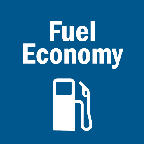1
181962
MPG is a subject on a lot of minds with current gas prices. It's worth looking at the parameters the EPA specifies for automaker testing. The EPA itself only tests around 10 - 20% of vehicles either in response to consumer complaints or random spot checks.
The following link shows the parameters of the 5 test cycles the EPA prescribes. Once at that web page click on the Test Details tab to see the specifics.
 www.fueleconomy.gov
www.fueleconomy.gov
These tests are done on a dynamometer simulating wind resistance. Interestingly, fuel consumption is measured by analyzing tailpipe emissions, not an actual measurement of fuel consumed. Also, the EPA specifies non-oxygenated fuel and then applies a 3% adjustment to get to an E10 BTU equivalence. There all kind of other factors even deeper in the weeds, but for the purposes of understand what "city" and "highway" actually mean, that table will suffice.
Note there are three City cycles in the table, the first, fourth and fifth columns, that are blended to come up with a City rating. Note the top speed of all three is 54.8 - 56 mph. Two of the three have max acceleration of 3.3 mph/second, quite pokey. The stops are about every half mile, give or take, for all three. It's hard to tell which cycle would yield the best fuel economy given the cold vs. warm starts and differences in ambient temp and A/C usage.
Suffice it to say, the pokey acceleration, the stops every half mile, the top speed achieved and the 18-19% idling time would not be "city" driving in the minds of many unless it is 2:00 AM. "City" looks more like moderately to densely populated suburbs and even then many would not be able to achieve any of those cycles in rush hour, maybe only in off hours.
Turning to the "Highway" test cycle, if one thinks of "Highway" as gassing up, getting on the expressway, and then driving 300 miles without getting bogged down in stoppages, you would be mistaken. While the Highway cycle has a top speed of 60 mph, it only covers 11 miles from a standing start. With the high rate of burn in getting up to speed, albeit in a pokey fashion, you might expect better doing 70 over hundreds of miles from one standing start.
I'm not sure what to make of the "High Speed" cycle or how that is blended in, perhaps in the combined city/highway. 80 MPH top speed, max acceleration of a 8.46 mph/second (probably in the first seconds from a stop) with 4 stops over a scant 8 miles covered in about 10 minutes.
Also, if you're out on a highway road trip and measuring your MPGs, take note of which way the wind is blowing. A 15 mph tail wind vs. a 15 mph headwind is a 30 mph difference in wind resistance. In my limited unscientific observations with my CX-5 I've seen about a 2-3 mph difference in one vs. the other.
The following link shows the parameters of the 5 test cycles the EPA prescribes. Once at that web page click on the Test Details tab to see the specifics.
Detailed Test Information
EPA tests vehicles by running them through a series of driving routines, or schedules, that specify vehicle speed for each point in time during the laboratory tests.
These tests are done on a dynamometer simulating wind resistance. Interestingly, fuel consumption is measured by analyzing tailpipe emissions, not an actual measurement of fuel consumed. Also, the EPA specifies non-oxygenated fuel and then applies a 3% adjustment to get to an E10 BTU equivalence. There all kind of other factors even deeper in the weeds, but for the purposes of understand what "city" and "highway" actually mean, that table will suffice.
Note there are three City cycles in the table, the first, fourth and fifth columns, that are blended to come up with a City rating. Note the top speed of all three is 54.8 - 56 mph. Two of the three have max acceleration of 3.3 mph/second, quite pokey. The stops are about every half mile, give or take, for all three. It's hard to tell which cycle would yield the best fuel economy given the cold vs. warm starts and differences in ambient temp and A/C usage.
Suffice it to say, the pokey acceleration, the stops every half mile, the top speed achieved and the 18-19% idling time would not be "city" driving in the minds of many unless it is 2:00 AM. "City" looks more like moderately to densely populated suburbs and even then many would not be able to achieve any of those cycles in rush hour, maybe only in off hours.
Turning to the "Highway" test cycle, if one thinks of "Highway" as gassing up, getting on the expressway, and then driving 300 miles without getting bogged down in stoppages, you would be mistaken. While the Highway cycle has a top speed of 60 mph, it only covers 11 miles from a standing start. With the high rate of burn in getting up to speed, albeit in a pokey fashion, you might expect better doing 70 over hundreds of miles from one standing start.
I'm not sure what to make of the "High Speed" cycle or how that is blended in, perhaps in the combined city/highway. 80 MPH top speed, max acceleration of a 8.46 mph/second (probably in the first seconds from a stop) with 4 stops over a scant 8 miles covered in about 10 minutes.
Also, if you're out on a highway road trip and measuring your MPGs, take note of which way the wind is blowing. A 15 mph tail wind vs. a 15 mph headwind is a 30 mph difference in wind resistance. In my limited unscientific observations with my CX-5 I've seen about a 2-3 mph difference in one vs. the other.
Last edited by a moderator:
